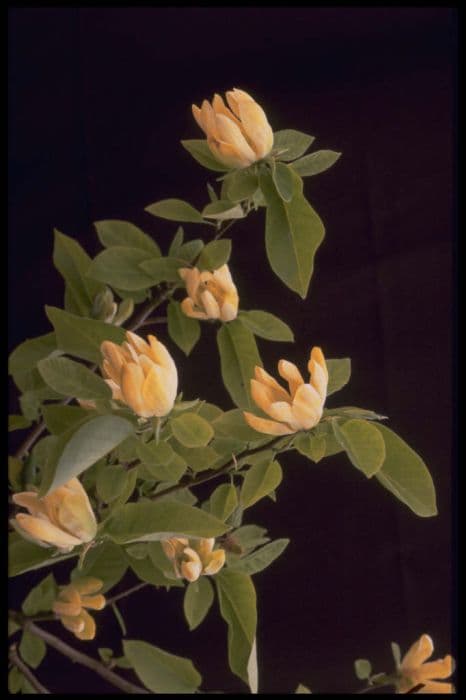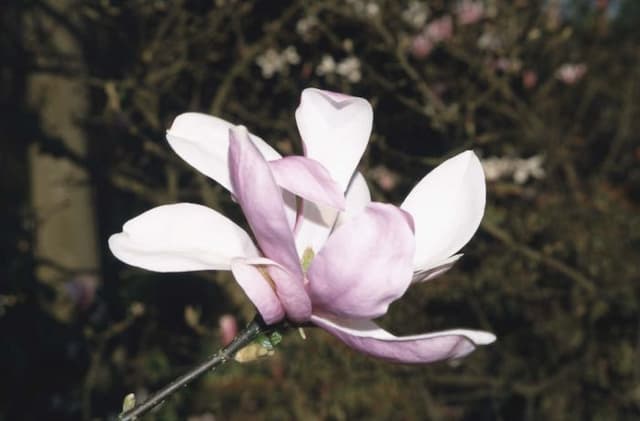Jane Magnolia Magnolia 'Jane'

ABOUT
Magnolia 'Jane' is known for its strikingly beautiful flowers and lush, glossy foliage. This deciduous shrub has an elegant appearance, often bringing grace and charm to gardens. The signature flowers are large and tulip-shaped, displaying a lovely blend of purple and pink on the outside with soft whitish-pink interiors. These blooms have a subtle, pleasing fragrance and emerge on the branches before the leaves unfurl, providing a spectacular spring display. The leaves of 'Jane' are oval to oblong, with a smooth, leathery texture and a shiny, dark green color that turns to attractive shades of yellow and bronze in the fall. The plant's branching structure is multi-stemmed, creating a rounded and somewhat open habit that allows the flowers to be well-displayed. It creates a striking visual interest, especially when the blooms are in contrast with the dark, handsome leaves. The overall appearance is one of serene beauty, making Magnolia 'Jane' a popular choice for ornamental and landscape use.
About this plant
 Names
NamesFamily
Magnoliaceae.
Synonyms
Jane Magnolia, Jane Tulip Tree, Jane Magnolia Tree.
Common names
Magnolia 'Jane'
 Toxicity
ToxicityTo humans
Magnolia 'Jane', commonly known as magnolia, is not considered to be toxic to humans. However, as with many plants, individual sensitivities can vary, and ingesting large quantities may cause gastrointestinal discomfort or an allergic reaction in some people. If any part of the plant is ingested and adverse symptoms occur, it’s advisable to seek medical attention.
To pets
Magnolia 'Jane', commonly known as magnolia, is generally not considered poisonous to pets. While the plant is not specifically listed as toxic, eating large amounts of the leaves or blooms could potentially lead to gastrointestinal upset in some pets, as with most non-food plants. If your pet ingests part of a magnolia and shows signs of distress, such as vomiting or diarrhea, it's best to consult your veterinarian.
 Characteristics
CharacteristicsLife cycle
Perennials
Foliage type
Deciduous
Color of leaves
Green
Flower color
Pink
Height
10-15 feet (3-4.5 meters)
Spread
6-8 feet (1.8-2.4 meters)
Plant type
Shrub
Hardiness zones
4-8
Native area
North America
Benefits
 General Benefits
General Benefits- Aesthetic Appeal: Adds visual interest to the landscape with its striking purple-pink flowers that bloom in late spring.
- Seasonal Interest: Offers early spring blossoms and can have a second bloom period in late summer or fall.
- Drought Tolerance: Once established, it has moderate drought tolerance, reducing the need for frequent watering.
- Cold Hardiness: Can survive in colder climates, hardy to USDA Zones 4 through 7.
- Compact Size: 'Jane' is a smaller magnolia cultivar, suitable for smaller gardens or limited spaces.
- Low Maintenance: Requires minimal pruning and is relatively low maintenance compared to other flowering trees.
- Pollinator-Friendly: Attracts bees, butterflies, and other pollinators, supporting local ecosystems.
- Landscape Versatility: Can be used as a specimen tree, in borders, and woodland gardens, providing design flexibility.
- Deciduous Foliage: Its leaves turn yellow to brown in the fall, adding to the plant's seasonal interest.
- Deer Resistance: Less appealing to deer, which can help to prevent damage to the plant and its blooms.
 Medical Properties
Medical PropertiesThis plant is not used for medical purposes.
 Air-purifying Qualities
Air-purifying QualitiesThis plant is not specifically known for air purifying qualities.
 Other Uses
Other Uses- Culinary decoration: The petals of Magnolia 'Jane' can be used to add a decorative touch to salads and desserts, just ensure they're free of pesticides before using.
- Photography subject: Its large, attractive blooms make Magnolia 'Jane' a popular subject for photographers, particularly in spring.
- Fabric dye: The petals and bark of Magnolia 'Jane' can be used to create a natural dye for fabrics, yielding subtle colors.
- Perfume: The essential oils extracted from the flowers of Magnolia 'Jane' can be used in homemade perfumes for a soft floral scent.
- Handmade paper: Incorporating Magnolia 'Jane' petals into handmade paper can add texture and interest to the artisanal product.
- Candle making: Dried petals of Magnolia 'Jane' can be used in candle making to add a natural element and soft fragrance to handmade candles.
- Floral water: The flowers can be used to create a magnolia-flavored water, which can be used as a calming facial toner or in aromatherapy.
- Feng shui: Some practitioners use the plant to create a sense of balance and harmony within the home according to feng shui principles.
- Artistic inspiration: Magnolia 'Jane' often serves as inspiration for artists and crafters, from painting to mixed-media projects.
- Education: The plant serves as a great example for teaching about pollination, plant life cycles, and the change of seasons in educational settings.
Interesting Facts
 Feng Shui
Feng ShuiThe Magnolia is not used in Feng Shui practice.
 Zodiac Sign Compitability
Zodiac Sign CompitabilityThe Magnolia is not used in astrology practice.
 Plant Symbolism
Plant Symbolism- Purity: Magnolia flowers are often associated with purity due to their pristine and elegant appearance.
- Nobility: With their impressive stature and grandeur, magnolias symbolize a sense of dignity and nobility.
- Persistence: Magnolias have a strong ability to survive and adapt in hard conditions, representing persistence and endurance.
- Feminine beauty: The magnolia's large petals and delicate fragrance have long been linked with grace and feminine beauty.
- Peace and Tranquility: The lush foliage and calming presence of the magnolia tree convey a message of peace and tranquility.
 Water
WaterJane Magnolia trees should be watered deeply once a week during their first growing season to help establish a strong root system. After they are established, they should be watered once every two to three weeks, depending on climate and soil conditions. Each watering session should provide the tree with about 5 gallons of water, ensuring that the moisture reaches deep into the soil. In periods of drought or extreme heat, increase the frequency of watering to prevent the soil from drying out completely. It's always better to water the tree deeply and less frequently than to water it a little bit every day, which encourages shallow root growth.
 Light
LightJane Magnolias thrive best in full sun to partial shade. They should be planted in a location where they can receive at least 4 to 6 hours of direct sunlight per day. An ideal spot for this tree would be one that offers morning sunlight and some afternoon shade, as the intense heat of the late day sun can be a bit too strong, especially in hotter climates.
 Temperature
TemperatureJane Magnolia prefers a temperature range between 60 to 70 degrees Fahrenheit for optimal growth. They can withstand minimum winter temperatures down to about -20 degrees Fahrenheit. During the summer, they can tolerate high temperatures up to around 90 degrees Fahrenheit, but they need protection from extreme heat during prolonged heat waves.
 Pruning
PruningPruning a Jane Magnolia is typically done to shape the tree or remove damaged branches and should be carried out after the tree has finished blooming in late spring or early summer. Pruning is not required every year but should be done as needed to maintain the tree's health and appearance. Remove any dead, diseased, or crossing branches to improve air circulation and light penetration within the canopy.
 Cleaning
CleaningAs needed
 Soil
SoilThe Jane Magnolia flourishes in rich, well-draining soil with a slightly acidic pH, ideally between 5.5 and 6.5. A successful potting mix can be created with a blend of 1/3 sand, 1/3 garden soil, and 1/3 compost or peat moss to ensure proper drainage and fertility.
 Repotting
RepottingJane Magnolias are slow-growing and generally do not require frequent repotting. If potted, repotting every 3 to 5 years in the spring should suffice, ensuring to use a large container that accommodates their root system.
 Humidity & Misting
Humidity & MistingJane Magnolias tolerate a range of humidity levels but prefer average to high humidity. They thrive in outdoor environments where natural humidity is present, without the need for specific humidity adjustments.
 Suitable locations
Suitable locationsIndoor
Place in bright, indirect light and ensure good air flow.
Outdoor
Plant in full sun to partial shade, shelter from strong winds.
Hardiness zone
4-8 USDA
 Life cycle
Life cycleThe life cycle of the 'Jane' Magnolia (Magnolia x 'Jane') begins with germination, where the seed, after being exposed to stratification through the winter, sprouts in the spring. The seedling stage follows, during which initial growth is slow as the plant establishes a root system and produces its first leaves. As the plant enters the juvenile stage, it starts to grow more rapidly, developing a strong stem and branching structure. This magnolia then reaches maturity, capable of producing its characteristic tulip-shaped, purple-pink flowers, usually after a few years. The mature plant enters a period of reproductive growth, blooming annually in early spring before the leaves appear, and producing seeds enclosed in cone-like fruit that mature and are released in late summer. Finally, as a perennial woody plant, 'Jane' Magnolia may continue to live, grow, and reproduce for many decades before eventually senescing.
 Propogation
PropogationPropogation time
Spring-Early Summer
The most popular method for propagating Magnolia 'Jane' is by softwood cuttings, which is typically done in late spring or early summer when the plant's growth is most active. To propagate by this method, a gardener will select a healthy, non-flowering shoot and cut a segment approximately 4 to 6 inches (10 to 15 cm) long. The lower leaves are removed, and the cut end may be dipped in rooting hormone to encourage root development. The cutting is then planted in a pot filled with a sterile, well-draining potting mix, ensuring that at least two nodes (where leaves were attached) are buried as these areas are where roots are most likely to emerge. The pot should be kept in a warm, humid environment with indirect sunlight, and the soil must be maintained consistently moist but not waterlogged. Roots typically develop within a few weeks, after which the new Magnolia 'Jane' can eventually be transplanted outdoors.



![Magnolia [Black Tulip]](/_next/image?url=https%3A%2F%2Fplants-admin.emdemapps.com%2Fimages%2Fplants%2F%2Fimages%2F604b590290fc7.png&w=640&q=75)





